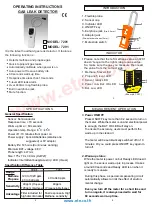
13
BOBBING METHOD
1.
Turn disc knob to “AUTOTUNE”, this puts you into
Autotune mode. Set the “SENSITIVITY” control so that
you just barely hear a threshold hum.
Hold the search coil 6 to 12 inches over the ground
and at least 3 feet away from any metal objects. Do
not use the PINPOINT button during any part of this
procedure.
2.
Lower the coil an inch or two above the ground and
then quickly raise it. Note that as you lower the coil,
the tone disappears then gets louder as you raise it
and finally returns to normal when you stop it 6 to 12
inches above the ground. Conversely, if you set the
GROUND control to “1,” the threshold hum will get
louder as you lower the coil and disappear when
you raise it.
3.
Your objective now is to adjust the GROUND control
so that there is no change, or only a minimum
change in the threshold hum, as you move the coil
up and down. Start by lowering the GROUND control
to “9.” Lower the coil and raise it again. One of three
things will happen to your threshold hum:
a)
It will fade again as you lower the coil and
increase as you raise it. Continue to lower the
ground balance setting in small increments until
the threshold hum remains the same (or changes
very little) as the coil is lowered and raised.
b)
lt will get louder as you lower the coil and go
silent as you raise it. You have gone past the
correct ground-balance setting. Increase the
ground-balance level (rotating the control
counterclockwise) in small increments until there
is little or no change in the threshold level.
c)
The hum will remain the same, or if it changes
slightly, the change is the same whether you
lower or raise the coil. Your CZ-21 is properly
ground balanced, and you are ready to begin
searching.
GROUND BALANCING
28
RECOVERY TOOLS
1.
Sand scoops designed especially for beachcombers
and shallow-water treasure hunters are available at
metal detector outlets.
2.
Divers use a variety of recovery tools, depending
on the condition of the sea bed or lake bottom. A
sturdy dive knife will suffice in packed mud or small
rocks. Most divers prefer to use their hands in loose
sand. Professional treasure hunters often use an air
hose fed by a surface compressor to blow away
loose sand, gravel or mud.
3.
For land recovery, a sturdy hunting knife with a 5-inch
blade will suffice in most soils. A high quality, double
edged “survival” knife is an even better choice (and
more expensive) because it will be almost impossible
to bend or break.
CAUTION:
Using a jack knife without a locking blade
is a good way to lose a finger.
4.
A heavy duty, blunt screwdriver is commonly used
for shallow targets where digging or “plugging” is
objectionable.








































